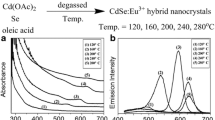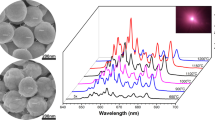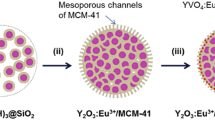Abstract
Eu3+ doped-CdTe (CdTe:Eu3+) nanocrystals were prepared via a facile hydrothermal method, and Eu3+ was successfully incorporated into the crystal lattice of CdTe and measured by X-ray powder diffraction (XRD), transmission electron microscopy (TEM), ultraviolet–visible (UV–Vis) absorption spectroscopy and fluorescence emission. The CdTe:Eu3+ nanocrystals still have a cubic crystal structure, and the corresponding XRD peaks of CdTe:Eu3+ nanocrystals shift to larger angles compared with those of pure CdTe. The CdTe:Eu3+ nanocrystals are monodisperse and the particles size is about 2–4 nm. Compared with pure CdTe, the CdTe:Eu3+ nanocrystals have larger band gap and thus exhibit blueshift in the emission spectra, which could be accounted for by the energy transfer between Eu3+ and CdTe. To enhance the stability and functionality of CdTe:Eu3+ nanocrystals, the CdTe:Eu3+ nanocrystals were coated with SiO2 and the core–shell SiO2-coated CdTe:Eu3+ nanocrystals (CdTe:Eu3+@SiO2) were prepared via micro-emulsion method. TEM results show that CdTe:Eu3+ nanocrystals are uniformly dispersed in the shell, and CdTe:Eu3+@SiO2 nanospheres are uniformly spherical with an average diameter of about 75 nm. The fluorescence emission of CdTe:Eu3+@SiO2 (567 nm) shows a blueshift compared with that of CdTe:Eu3+ nanocrystals (632 nm), possibly because of altered surface properties after SiO2 coating. CdTe:Eu3+ and CdTe:Eu3+@SiO2 with tunable photoluminescence are potentially useful in fabricating optical and bioimaging devices.









Similar content being viewed by others
References
Huang HQ, Liu JL, Han BF, Mi CC, Xu SK. Cell labeling and cytotoxicity of aqueously synthesized CdTe/CdS/ZnS core–shell–shell quantum dots by a water bath-hydrothermal method. J Lumin. 2012;132(4):1003.
Liu P, Wang Q, Li X. Studies on CdSe/l-cysteine quantum dots synthesized in aqueous solution for biological labeling. J Phys Chem C. 2009;113:7670.
Kumar R, Nyk M, Ohulchanskyy TY, Flask CA, Prasad PN. Combined optical and MR bioimaging using rare earth ion doped NaYF4 nanocrystals. Adv Funct Mater. 2009;19(111):853.
Jiang ZY, Zhu KR, Lin ZQ, Jin SW, Li G. Structure and Raman scattering of Mg-doped ZnO nanoparticles prepared by sol–gel method. Rare Met. 2018;37(10):881.
Jin H, Wang YY, Wang YT, Yang HB. Synthesis and properties of electrodeposited Ni–CeO2 nano-composite coatings. Rare Met. 2018;37(2):148.
Han X, Zhang JM, Zhang K, Wang TY. Synthesis and modification of water-soluble CdTe: Zn quantum dots. Chin J Rare Met. 2015;39(10):909.
Zebardastan N, Khanmirzaei MH, Ramesh S, Ramesh K. Performance enhancement of poly (vinylidene fluoride-co-hexafluoro propylene)/polyethylene oxide based nanocomposite polymer electrolyte with ZnO nanofiller for dye-sensitized solar cell. Org Electron. 2017;49:292.
An QZ, Fassl P, Hofstetter YJ, Becker-Koch D, Bausch A, Hopkinson PE, Vaynzof Y. High performance planar perovskite solar cells by ZnO electron transport layer engineering. Nano Energy. 2017;39:400.
Yu JJ, Liao B, Zhang X. Fabrication of 3D ZnO/CuO nanotrees and investigation of their photoelectrochemical properties. Chin J Rare Met. 2018;42(5):450.
Buonsanti R, Milliron D. Chemistry of doped colloidal nanocrystals. Chem Mater. 2013;25(8):1305.
Ishizumi A, Taguchi Y, Yamamoto A, Kanemitsu Y. Luminescence properties of ZnO and Eu3+-doped ZnO nanorods. Thin Solid Films. 2005;486(1–2):50.
Zhang WJ, Li Y, Zhang H, Zhou XG, Zhong XH. Facile synthesis of highly luminescent Mn-doped ZnS nanocrystals. Inorg Chem. 2011;50(20):10432.
Murray CB, Norris DJ, Bawendi MG, Murray CB, Norris DJ, Bawendi MG. Synthesis and characterization of nearly monodisperse CdE (E = S, Se, Te) semiconductor nanocrystallites. J Am Chem Soc. 1993;15(19):8706.
Zhang H, Wang LP, Xiong HM, Hu LH, Yang B, Li W. Hydrothermal synthesis to high quality CdTe nanocrystals. Adv Mater. 2003;15(20):1712.
Wang Q, Zhou XL, Fang TT, Liu P, Li X, Min XM. One-step growth of high-quality CdTe quantum dots via hydrothermal method and cytotoxicity evaluation. Powder Technol. 2013;247:81.
Nogami M. Fluorescence properties of Eu-doped GeO2–SiO2 glass heated under an H2 atmosphere. Lumin. 2001;92(4):329.
Hamnabard N, Hanifehpour Y, Khomami B, Joo SW. Synthesis, characterization and photocatalytic performance of Yb-doped CdTe nanoparticles. Mater Lett. 2015;145:253.
Hanifehpour Y, Hamnabard N, Khomami B, Joo SW, Min BK. A novel visible-light Nd-doped CdTe photocatalyst for degradation of Reactive Red 43: synthesis, characterization, and photocatalytic properties. J Rare Earths. 2016;34(1):46.
Franc J, Horodysky P, Grill R, Kubat J, Saucedo E, Sochinskii NV. Characterization of optical and electrical properties of CdTe: Yb co-doped with Ge. J Cryst Growth. 2006;286(2):384.
Mathew S, Rejikumar PR, Adiyodi AK, Jyothy PV, Unnikrishnan NV. Structural and optical characterization of oxygenated CdTe/Sm3+ in sol–gel silica glasses. Mater Chem Phys. 2008;112(3):1061.
Zhu YS, Cui SB, Chen X, Xu W, Zhou PW, Wang YF, Xu L, Song HW, Huang L, Huang W. Efficient energy transfer from inserted CdTe nanocrystals to YVO4:Eu3+ inverseopals: a novel strategy to improve and expand visible excitation of rare earth ions. Nanoscale. 2014;6(14):8075.
Xu HY, Zhang JH, Li FS. Synthesis and optical properties of CdTe:Eu3+ quantum dots. Chin J Lumin. 2016;37(3):306.
Yang YH, Gao MY. Preparation of fluorescent SiO2 particles with single CdTe nanocrystal cores by the reverse microemulsion method. Adv Mater. 2005;17(19):2354.
Zhang SH, Wen L, Yang JP, Zeng JF, Sun Q, Li Z, Zhao DY, Dou SX. Facile fabrication of dendritic mesoporous SiO2@CdTe@SiO2 fluorescent nanoparticles for bioimaging. Part Part Syst Charact. 2016;33(5):261.
Zhang Y, Liu Y, Li X, Wang QJ, Xie E. Room temperature enhanced red emission from novel Eu3+ doped ZnO nanocrystals uniformly dispersed in nanofibers. Nanotechnology. 2011;22(41):415702.
Park JY, Jeong DW, Lim KM. Multimodal luminescence properties of surface-treated ZnSe quantum dots by Eu. Appl Surf Sci. 2017;415:8.
Raola OE, Strouse GF. Synthesis and characterization of Eu-doped cadmium selenide nanocrystals. Nano Lett. 2002;2(2):1443.
Chen YF, Chen Z, He YJ, Lin HL, Sheng PT, Liu CB, Luo SL, Cai QY. L-cysteine-capped CdTe QD-based sensor for simple and selective detection of trinitrotoluene. Nano-technology. 2010;21(12):125502.
Ashwini K, Yashaswinia B, Pandurangappa C. Solvothermal synthesis, characterization and photoluminescence studies of ZnS:Eu nanocrystals. Opt Mater. 2014;37:537.
Kabongo GL, Mhlongo GH, Malwela T, Mothudi BM, Hillie KT, Dhlamini MS. Microstructural and photoluminescence properties of sol–gel derived Tb3+ doped ZnO nanocrystals. J Alloys Compd. 2014;591:156.
Luo WQ, Liu YS, Chen XY. Lanthanide-doped semiconductor nanocrystals: electronic structures and optical properties. Sci China Mater. 2015;58(10):819.
Ning ZD, Zhang JM, Wei J, Cheng YY. CdTe@SiO2 particles prepared via reverse microemulsion method and its fluorescence properties. J Tianjin Polytech Univ. 2012;31(1):50.
Song HY, Leem YM, Kim BG, Yu YT. SiO2-coated ZnS submicrospheres with enhanced thermal stability and photoluminescence. Mater Sci Eng. 2007;B143:70.
Acknowledgements
This work was financially supported by the National Natural Science Foundation of China (No. 21364007), the Natural Science Foundation of Inner Mongolia (No. 2016MS0201) and the Program for Young Talents of Science and Technology of Baotou Teachers College (No. 01135003).
Author information
Authors and Affiliations
Corresponding author
Rights and permissions
About this article
Cite this article
Gao, JF., Yang, JH., Zhang, XY. et al. Synthesis and fluorescence properties of CdTe:Eu3+ nanocrystals and core–shell SiO2-coated CdTe:Eu3+ nanospheres. Rare Met. 38, 989–995 (2019). https://doi.org/10.1007/s12598-018-1180-1
Received:
Revised:
Accepted:
Published:
Issue Date:
DOI: https://doi.org/10.1007/s12598-018-1180-1




